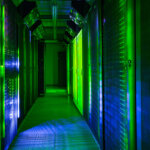Green data centers and the Super Bowl Sunday effect

The fundamental equation of data centers as we’ve been used to developing them is increasingly incompatible with the kind of growth we’re seeing, and the quantum leap of growth we can expect as technologies like cloud-first environments, quantum computing, and increasingly sophisticated amounts of AI and machine learning become central to our everyday lives.
Data centers consume 10 to 50 times the energy per unit of floor space of a typical commercial office building. Think of that in real terms for a second. Say for instance one person uses one unit of floor space, with their lighting and laptop and aircon and whatever else they need. Now add another 49 people into the same space. 49 more laptops. The energy draw you’re looking at is a scale model of a data center.
That means the quest for greener data center solutions is becoming increasingly urgent.
Cirrus Nexus, a cloud management platform, recently conducted a snapshot analysis of power grid regions in the US and Europe to find which regions were best – and worst – in terms of carbon emissions.
We spoke to Chris Noble, CEO and co-founder of Cirrus Nexus, to ask him what was what.
Universal intent?
THQ:
Is it accurate to assume that the whole of the data center industry is at least aiming to become as carbon neutral as possible? And are we seeing what feels like sufficient reasonable effort by the industry across the board?
CN:
That’s a tough one to answer. The reality is, everybody’s talking about it, and a lot of people are looking at that what it’s going to take to get there.
When it really matters, when it boils down to deploying, going to market and so forth, there’s a lot of conversation around how to get there, and what can be done economically to get there. There are a lot of things that companies can do to advance that further. But the technologies are either relatively new, or costly, or not as proven as they need to be. Some of the aspects that you really need to bring together a really clean data center just don’t have the testing yet.
There’s definitely genuine interest in doing it, because the market is being pushed that way – consumers want clean data, they want a clean environment. Companies are getting that pressure from consumers to produce products that are clean, and to act in a clean and ecologically friendly manner. So that’s driving that behavior.
Now companies are looking at one of the things that we do, which is work out the carbon emissions for individual companies, so when they go out and get their computer resources from third-party companies and cloud vendors, they want to know what that cloud footprint is, because they have to report it, specifically in Scope 3. So that combination of consumer demand and necessary reporting is really driving their behavior towards cleaner solutions. So there’s genuine interest, and there’s at least some movement in the right direction. But we have a long way to go.
A future truly viable?
THQ:
We’ve spoken to other people about similar issues recently, and the idea of, for instance, achieving net zero by 2030 was described to us as “viable, but requiring a hell of a lot of investment, research and active focus on the doing of it, rather than just the goodwill.” Does that sound familiar?
CN:
Well, the bass technologies actually exist, right? The ability to produce clean energy exists. But a lot of those technologies are a matter of bringing elements together and deploying them in the right way. And then there’s politics, and there’s the fact that billions and billions of dollars have already invested into these data centers. Retrofitting those data centers in the right ways really stretches out that funding.
THQ:
Got an example?
CN:
Sure. Without getting too deeply into things, take the modular nuclear reactor. That’s an adaptation of military technology for power generation, and all the other components that go into it are there, they’re just… costly. And it’s going to take a lot of investment and a lot of incentive, and a lot of drive to get to the point where we start putting that all together, building out these new hyperscaling data centers with all those technologies.
THQ:
We described this recently as the rock and the hard place of greener data centers. The need for more data centers, and the need to make them greener. Add in the cost of making them greener and the whole thing slows down significantly, doesn’t it?
CN:
Yeah. We have some statistics that we know, which are really vital in this area. The amount of energy required by a data center doubles every four years.
What that really means is that by 2040, it will use more power than is produced today. That’s a tremendous amount of power. How do you build out that much power? How do you get those technologies deployed? How do you make it cost effective?
The study we did into different regions, and where was doing it more effectively – which is to say with fewer carbon emissions. We’ve seen data centers and providers out there saying, “Oh, we’re gonna build in this region, because it’s got solar.”
Well, okay. It’s great when the sun shines, but what happens when it doesn’t – what do you do? A lot of a lot of things that we see in the market don’t take into account overall demand, right? So they talk about what their requirements are, but they don’t look at demand in the region itself, which drives the thing.
The Super Bowl Sunday effect.
A perfect example of that is Super Bowl Sunday. The power industry always loves to talk about Super Bowl Sunday, because they know that on that day, there’s going to be an abnormal peak in power drain, right, because you can be more than usually guaranteed that for a given period of time, more people’s TVs will be on at once. So they have to spin up more, do more power generation, and with something like Super Bowl Sunday, they know it’s coming.
During that period of time, obviously, the only way that they are currently able to do it is to spin up fossil fuels. That’s the only way they can meet that peak demand. And if the Super Bowl happens, and you’re in an area where there’s no wind and it’s cloudy, you’re not going to get the benefits of solar and wind to compensate. So that in effect makes the data center that much more carbon-intensive during that period, because it’s going to pull more power off the grid that’s not clean.
In terms of power distribution across regions and how you do that, that’s what the US did when it passed the IRA – which is just a horrible name for an environmental bill. But a lot of that addresses power distribution. So if you look at California, California has the benefit of a lot of space, but it also has the biggest electrical grid connection to the American Northwest – which has a lot of hydro.
The question of storage.
So at night, when the Northwest doesn’t need as much power, that hydro is still being generated, so they pump that down to California, and that helps offset that solar/wind supply. The Midwest goes from being very carbon-intensive to having very little carbon intensity. And based on that, and the data on the weather, and the sun and so forth, that region has enough space to generate enough power to run everything, but now you get into the distribution, and of course, the politics behind that involve a lot of Not In My Backyard thinking and everything that goes along with that.
THQ:
We were going to say, the logical thing to do would be to get every source that you can, and if you can feed it into a stable grid, then –
CN:
Exactly. And store it – that’s another component which is so desperately needed: energy storage. Even if you’re producing a lot of nuclear power, even if you’re producing power with wind and solar to offset that, you still have to be able to store it so it can go back into the grid.
THQ:
We begin to see what you mean by there still being a long way to go…
In Part 2 of this article, we’ll dive deeper into the Cirrus Nexus report on energy greenness in various areas, and see if we can get closer to the dreamed-of green data future.










